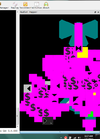FAQ
Jump to navigation
Jump to search
I've got my map pulled up, and it looks all jumbled, like this:
Where can I get it?
- Mudlet can be downloaded from SourceForge at: http://mudlet.sourceforge.net/wordpress/?page_id=30
- You can download the source code of the latest git-version here: http://mudlet.git.sourceforge.net/git/gitweb.cgi?p=mudlet/mudlet;a=snapshot;h=HEAD;sf=tgz
- You can access the git repository with all versions here (choose "snapshot" to download the source of the respective git commit): http://mudlet.git.sourceforge.net/git/gitweb.cgi?p=mudlet/mudlet;a=summary
- ***NOTE*** You need to link mudlet against the qt-4.6-sdk libs available from qt.nokia.com. Otherwise you'll get random crashes due to broken/incompatible qt and other system libs on your particular Linux distro. Install the sdk into your home directory. It does not interfere with your system qt installation. To link against the qt-sdk libs you need to use qmake from the sdk, then make. make install is no longer supported. Consequently, you need to run mudlet from mudlet/src directory with ./mudlet.
Is there a Manual?
- Yes. The manual and supporting documentation can be found here: Manual:Contents
I've got my map pulled up, and it looks all jumbled, like this: 
- In the above example, click on the long blue arrow. There will be spinners for Rooms and Exits. If you adjust what you have towards the general vicinity of the values in the following image, it should get better.
I am interested in making my own GUI (Graphical User Interface). I want pictures and gauges and all sorts of fancy things
- Well, you're in luck. You can do some pretty cool stuff with Mudlet. In fact, at the moment there are three primary options for creating your own GUI. Which one you choose will ultimately depend on what you are trying to accomplish.
- 1. I want to create a full heads up display, with stuff on all the edges and pictures and the like.
- Well, you may want to look into Vyzor. It is created specifically with this in mind, and will give you easy access to all four edges of the screen. When using Vyzor, it is recommended you stick strictly with Vyzor, but there is some pretty good documentation linked from the Vyzor page itself, including a sample walkthrough.
- 1. I want to create a full heads up display, with stuff on all the edges and pictures and the like.
- 2. I want a nice toolkit for making widgets, or even full blown GUIs by bolting widgets together.
- You may be interested in Geyser. You can create complex, intricate, full featured GUIs using this tool, or also very simply create a small console to just echo some text to. The manual for this GUI framework can be found here: Manual:Geyser
- 2. I want a nice toolkit for making widgets, or even full blown GUIs by bolting widgets together.
- 3. I prefer to cook up my own solutions from scratch. I want the barebones access to the UI elements.
- Welcome, intrepid adventurer. It is indeed true that both Geyser and Vyzor are frameworks which are built upon the UI functionality provided by Mudlet itself. If you wish to forge your own trail and so on and so forth, then you will want to spend a lot of time meditating upon this tome: Manual:UI_Functions
- 3. I prefer to cook up my own solutions from scratch. I want the barebones access to the UI elements.
What is all this regular expressions / regex / pcre voodoo going on? Where can I get more information?
- Regular expressions can seem a bit like black magic until you get to know them a bit better. Once you've created a few they come much more easily. Here are some places you can go for more information.
- PCRE regular expression tutorial & reference: http://www.regular-expressions.info/reference.html
- PCRE manual: http://www.pcre.org/pcre.txt
I've glanced at the manual, or perhaps even read it more in depth, but I don't understand something. What now?
- Well, we have a few different options here. For real-time interactive help, we have an IRC channel on freenode, #mudlet. You can get there using THIS LINK.
- There are also the [forums.mudlet.org Mudlet forums] where you can search to see if someone else has posted a similar question, and if not post it yourself.
- You can also try searching the wiki to see if the subjest comes up in any other pages. This can sometimes contextualize a concept, and provide a sort of "Aha!" moment.